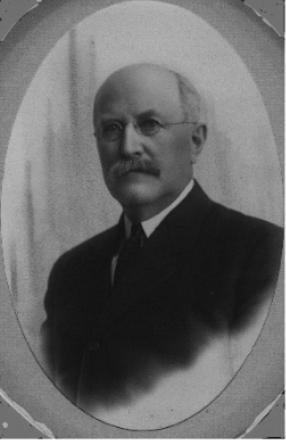EARLY
DAYS IN CARSON COUNTY TEXAS
By
Judge J.C. Paul
 |
In
the summer of 1887 the Santa Fe Railroad was building from Kiowa,
Kansas, southwest into Texas. It
was to have as its temporary terminus Panhandle City, in Carson County.
It
was at first understood that this line would eventually be constructed
farther southwest through New Mexico, and that the Ft. W. & D. Cy.
Railway, then building from Fort Worth to Denver, might cross the Santa
Fe line at Panhandle City. This
gave to Carson County a greater prominence than any other Panhandle
county then enjoyed.
|
Early
in the summer of 1887 a small group of settlers, headed by the late Judge 0. H.
Nelson, came into the county and filed on state lands immediately around
Panhandle City. Soon a few other
settlers came from other sections and the lands were surveyed and sectionized in
1887 by James L. Gray, now living in San Pedro, California.
He was then working for McClelland Bros., of Clarendon, Texas.
At
that time there were no roads or fences, except the fence enclosing the White
Deer lands, then known as the "Diamond F" Ranch.
This was a 600,000 acre property, managed by Colonel B. B. Groom, of
Kentucky, who was the first man to attempt farming in Carson County.
In
1887 the management of this extensive estate passed to George Tyng, of Victoria,
Texas, who began some scattered improvements on it, such as wells and windmills.
Colonel Groom had originally built an old house of cotton wood logs on
White Deer Creek, which was the first building erected in the County.
Mr. Tyng later moved the ranch headquarters to a point a few miles south
of where the town of White Deer now stands.
This ranch was afterwards subdivided and colonized most successfully by
Mr. T. D. Hobart.
The
buffalo had been killed off by thousands in the seventies and their bones lay in
piles just where they were shot. As
the railroad would furnish transportation for the bones, people came with
ox-teams and found profitable work gathering and bringing them to Panhandle
City, where hundreds of tons of them were piled along the prospective railroad
track.
In
1888 the first commercial use to which railroad trains were put, was the hauling
of hundreds of cars of bones to market - St. Louis and New Orleans, where they
were used for fertilizers and sugar refining.
Thus passed what was then known as the last of the buffalo - "The
Monarch of the Plains."
Returning
now to a description of the county as the writer first saw it in January, 1888.
It was a beautiful, smooth prairie, as far as the eye could see - not a
tree not even a shrub knee high, to hide a Jack-rabbit, for miles in every
direction. No fences, no roads, no houses, only a handful of people
around Panhandle, the only settlement then in all of that plains country.
The
sole occupants of the great plains were thousands of antelope, scattered far and
wide wherever one went. As I now
remember my early impressions, the one subject always discussed when
conversation lagged, was, "Will this country ever produce anything but
grass?" "Can farmers ever live here?" "Ought we to ever plow
up the land?"
The
older cattle men generally agreed that to plow up the original sod, was to
permanently ruin it. The writer now
confesses to have agreed with them for the first ten years he was there.
In
this early day, the saloons flourished, each with a gambling hall adjoining.
"Jim McIntire" and "Smoky Jim", two famous gamblers
helped to make the town famous.
Then,
too, the Dance Hall flourished. And many an old time cow-boy, such as Mac
Sanford and Cal Merchant, could tell interesting tales of how it felt to leave
town dead broke, to follow the chuck wagon another month.
The first schools taught in Panhandle were conducted Mrs.
Stone, (now Mrs F. H. Hill), who is the mother of Panhandle's present
Mayor, and by Miss Kate Roberts, who was the first lady married in Panhandle.
This marriage occurred in 1889, when Miss Roberts became the wife of Mr.
T. N. Adams, the first Sheriff in Carson County.
The
schools were taught in little vacant rooms wherever they could be had.
No school furniture was used the first two years.
The children sat on benches and boxes; there being only a few chairs for
the teacher and older pupils.
The first church was built in 1889, but there was no resident minister
for some time. Rev. R. L. Selle
was the first minister to live there. Rev.
B. F. Jackson, of Miami, frequently preached for us. Also Rev. Molyneaux of Amarillo.
For
several years the population could not support a doctor and the county had to
pay him a salary. Dr. Carter was
our first resident physician.
Carson
County was organized in 1888 with:
O.
H. Nelson, as County judge
W.
C. Bright, as County Clerk
T.
N. Adams, as Sheriff
J.
C. Paul, as County Treasurer
The
old courthouse, a wooden two story structure, was built in 1889, at a cost of
about $6000.
In those days the chief amusement was the old fashioned square dance, at
first held in some old store building and later in the courthouse.
Among the first fiddlers was Jess Wynne and Tommy Lorance, who never
failed to draw a crowd, and give them the worth of their money.
To these dances came cow-boys from everywhere. Every woman in the country danced. The Lee girls from Washburn, (Mrs. Jno. McKnight was one of them) and the Hibbett girls from Washburn
- Misses Anna and Hannah--all were good dancers and jolly folks.
T'hey usually danced all night, so they could go home by day light.
Any of those who joined in these parties will agree with me that those
were the best times we have ever known.
Later
on came the pony race and horse racing. Ed
Deahl came and brought his
thoroughbreds, but the old cow puncher never forsook his crack runner.
Many a dollar changed hands and many a fellow went home broke; but it was
soon forgotten when the boys met down at Jack Ivers saloon to talk it over and
perhaps up the gains and losses in an all night poker game.
Just here let me remark that it is the general belief that the poker
games begun in 1887 in Panhandle City seldom closed nights nor Sundays for ten
years. The big cattle shipments
made from Panhandle 1888 to 1895 brought hundreds of cow boys, ranch bosses and
camp followers there, and many thousands of dollars were lost and won in a
single night. The professional gamblers, of course were always the winners.
These were the days when big
herds were trailed through from Texas to Wyoming and Montana. Each outfit usually drove about 2500 head.
From the White Deer headquarters, from two to four herds were started
each year under the general direction and management of Jas.
L. Harrison. Time was no
object then, for the cattle improved on the fine grass and water along the way. Deer, antelope and wild turkey furnished ample food for the
men, and such trips usually took several months.
The
story of Carson County would not be complete without some mention of the legal
talent that then came periodically to our Courts. One of the most famous lawyers then was Temple Houston, with
his long hair, high heeled boots, Prince Albert coat and sombrero.
It was he who defended Dixie Lee, as told by the author of Cimarron, a
late book by Edna Ferber, now so popular in the movies.
Then,
another no less interesting character was W. H. Woodman, the poet lawyer to whom
was erected a memorial recently at Washburn. The elder judge Willis and Judge Griggsby and L. D. Miller,
and our own beloved Governor Browning, were all characters who left their
lasting impressions on all of our early settlers.
Our Judge S. H. Madden began his law
practice there.
The
early settlement here with its pioneers and their experiences were similar to
that previously enacted in dozens of other localities, where settlements had
been opened; for the continued growth and development of all America had begun,
and ended in small bands of venturesome restless settlers, pushing out into new
and unoccupied territory, to plant new colonies and build for themselves new
homes and fortunes.
The
history of all the states had been about the same from Jamestown, in Virginia
and Plymouth Colony in Massachusetts, down through the two or three centuries,
and through the settlements made in almost one hundred places in Ohio, Indiana,
Illinois, Missouri, Kansas and Nebraska, where the frontier seemed to end.
West
Texas, formerly designated on the map as the "Great American Desert",
furnished the last chance to plant a new colony just a little different from any
of the former settlements.
Into
the Midwest and into Illinois and Iowa, many Germans had come, in the Northwest,
Dakotas and Minnesota, the Scandinavians had predominated.
In Kansas and Nebraska religious sects - Mennonites, Dunkards and others
had settled. In all of these, the
process of adjusting these into a proper order of society had been slow and more
difficult. But into our Panhandle
country came only native Americans, with scarcely any mixture of foreign blood.
Many came from Kansas, Kentucky, Virginia, Ohio and Illinois, also
Missouri and Tennessee. This was
the "melting pot" for the energetic, ambitious and progressive
elements from all of the older settlements where more room and greater
opportunities were desired.
It
is this that accounts for the generally recognized fact that in Northwest Texas
we can boast of a population more purely American than in almost any other
Western community.
As
was always the case, the first influx brought the saloon, the gambling den and
the dance halls, but in due time, and by a natural process, all of these passed
out just as did the old dug-out, the box-house and the mud street.
Only
those who have really pioneered and helped to settle a new country can fully
appreciate the obstacles to be met and overcome at first.
With only a few hundred population, one man had to fill several
positions. The first year in
Panhandle, Mr. and Mrs. Pete Leithauser made themselves useful in the following
manner: She was a nurse and cook and washer woman.
Pete was at first a carpenter then became a plumber, then took up
undertaking and made boxes and buried the dead.
Then he took up barbering, and for lack of better material he was elected
justice of the Peace. So the two filled eight different positions all at the same
time. And it can be said truthfully
that they rendered acceptable service in every one of them.
I
have above failed to give all he did. At
one time Panhandle had no doctor, so Pete's versatility came in to play.
He bought a pair of Sears-Roebuck tooth forceps and began to pull teeth.
His first patient was a big, strong, country girl and the tooth-ache had
made her desperate. He tied her in
his barber's chair and began the struggle.
She kicked and screamed, but Pete finally got the tooth and this made the
ninth business they conducted.
Pete's
grand-father had been an Ohio pioneer. His
father had pioneered in Illinois. So
he had inherited the adaptability and the versatility so necessary to successful
pioneering in the Panhandle.
I
have said that Pete had been elected Justice of the Peace.
This qualified him to take acknowledgments.
As secretary and treasurer of the So.
K. Ry. Co. of Texas, at
Panhandle; the writer had to make elaborate, sworn monthly statements to the
State Comptroller. These statements
were prepared by J. N. Freeman, then Auditor of the road.
When Freeman and I had duly signed the first instrument, we together went
to Pete to have the oath administered. We
knew he had never before sworn anyone, and perhaps did not know the form of the
oath. But Pete knew there was a
dollar fee in it for him; so he blundered into it about as follows: "Do you
fellows both solemnly swear that what you wrote in that paper is the truth, the
whole truth and nothing but the truth, so help you by God?"
As
laughable as the foregoing incident was, it shows how useful ends may be
achieved by those who humbly try to serve their people and do their best.
Pete
had a long ancestry of pioneers who ran back to the Dutch, who came to
Massachusetts with the earliest settlers. Each
generation had built up and developed a greater aptness for the new work of
pioneering.
I
have not told you of this man's life in Panhandle merely as a personal incident,
but I am using him as a type of the new settlers, whom we encountered in all new
countries, whose tact and versatility came by generations of practice in doing
all of the kinds of work under all kinds of circumstances and whenever necessity
called for it.
As
I have said before, there were but a few settlers in Carson County for the first
few years. Many came and tried it;
but only a few of the very determined and heroic had the hardihood to stick it
through. They settled in widely
scattered places, where conditions seemed most favorable.
Very few had any near neighbors and none had even a fair chance of making
a living. Water, the most necessary
thing, was to be had only at Panhandle, where it was brought by the railroad
company from up near Miami, and each settler generally came to town once or
twice a week with one to four water barrels in his wagon and took home the
week's supply. Price was generally
50 cents a barrel,
The
writer remembers well how on Saturdays all the town people scanned the horizons
in different directions to catch glimpses of the twenty or thirty water-wagons
that made weekly visits. This
condition lasted several years, until it became known that water was to be found
in abundance everywhere by drilling for it.
It
can be easily seen that these scattered homes furnished only the plainest of
life's actual needs, none of its luxuries and but few of its necessities.
The people grew to appreciate what neighbors they had, even if a dozen
miles away. A spirit of friendship,
hospitality and helpfulness was fostered, that made real brothers of them all.
And we can but regret today the decadence of this old time spirit that is
often lacking in the newer and more modern communities.
In
the early Nineties the telephone came and in Carson County some twelve or
fifteen country homes were connected by a neighborhood phone line, run from
house to house on the barbed wire fence. Light,
cheap batteries were used at each house and each home had its call signal.
This was considered real civilized, and after the day's work was done,
everybody had to call everybody else and exchange the news.
That was just as novel then as the radio is now.
Of course we all had curiosity then, and sometimes the whole neighborhood
listened in when Mrs. Grundy was giving her neighbors a piece of unusually
interesting family or neighborhood news.
Those
early days were marked by a sameness that must then have seemed monotonous.
Many of us wondered often why we were there and why we did not leave.
There were no happenings to develop a hero or a heroine, but we got the
habit of staying on the job and sticking together.
One
fact worth recording is that we were each valued according to what we could do.
The simplest democracy was practiced.
I state with especial pride that in every local election, for ten or
fifteen years, no politics cut any figure.
No candidate for local office was ever asked to what party he belonged.
The chief qualification was his fitness to do the work.
In those days all were poor alike. Land
was worth practically nothing and there were no cattle barons in that county,
though a few big ranches.
In
1890 to 1893 came the panic. All
the railroads of the West were overbuilt and most of them went into the hands of
receivers. The cattle business was
at its lowest ebb ever known. Credit
was destroyed and stagnation had strangled every business.
With no deposits and no credits, bankers everywhere seemed hopelessly
broke.
My
little bank at Panhandle, serving only a few dozen people, had three to four
customers, who owed it an aggregate amount several times its capital stock.
Were they to break, certain failure would follow; but they did not fail,
and in a few years each paid up and normal conditions prevailed.
This has its bearing on present financial conditions. It shows that history will repeat itself.
It
was said that the Mayflower, landing on the bleak New England coast, in 1620,
had aboard an invisible cargo that contained the virile seeds that afterwards
sprouted and grew into a great Republic that now is the greatest of modern
nations.
In
a more remote and simpler way, is it too much to say that the little band of
home seekers who came to Carson County in 1887 and 1888, brought with them the
potency and force that was to ripen into a splendid community and spread its
influences to the whole Panhandle Country.
This
little group of prospectors had simple tastes, but must have had vision and
purpose to have fought so successfully the dust and the wind and the droughts,
through a period of ten or more weary years.
To
us, viewing their heroic deeds from only a few decades of time, we can scarcely
realize what valor and grit it took. But
when two or three more generations shall have passed, their greater foresight
and greater heroism and more earnest efforts will surely stamp them with
qualities of superior strength and character. Truly, they built better than they knew.
And in the years to come, posterity will accord to them a high place
among that noble group of American pioneers, who made the Prairie to blossom as
the rose.
From these thoughts of the
pioneer days, let us turn to the present Carson County, and see the changes Old
Time has wrought. To the early
settler the change is simply magical. For
Carson County now has more miles of hard surfaced roads than any other West
Texas County. She can point to the
biggest oil and gas wells, the greatest wheat yields and the best Guernsey milk
herds to be found anywhere in Texas. The
buffalo and the antelope have vanished and the best in cattle, hogs and horses
have taken their places. The old
cow trail has changed into a hard surfaced road; the auto has put the cow pony
to rest; and the daily Santa Fe train speeds along the once lonesome train,
bringing every luxury and pleasure that the oldest section enjoys.
Not
only the trans-continental trains are ours for greater progress, but the ships
of the air soar over us, singing their songs of praise that the old order of the
early days has passed.
The
few surviving settlers of 1887 and 1888 are Mr. and Mrs. E. E. Carhart, Tom
Cleck, J. E. Southwood, Mrs. F. H. Hill, Charley Wright and the writer, all of
Panhandle; also Jess Wynne, of Pampa, George Masters of Los Angeles, California,
Lee Masters, of Oregon, Al Holland of White Deer and A. S. McKinney of San
Simon, Arizona. D. C. Stone, now
mayor of Panhandle, was a child but three years old when he came in 1887.
Judge
J. E. Southwood and Al Holland have the distinction of being the first settlers
in Carson County who have lived there continuously since the first settlement.
The
present population of Carson County is wide awake, progressive, up-to-date and
are generally direct descendants of the first settlers who came to open the way,
and lead to the establishment of higher agencies of civilization, such as
schools, churches and roads.
To
have been one of these early pioneers and to have used well nigh a half century
of my life in an effort to help change this country from a desert into a highly
developed community, is given to but few of us. For me, I am glad to have had, even a small part, in helping
to bring such a change as is seldom experienced in one short life.
Surely our efforts "have made two blades of grass to grow where but
one had grown before."



